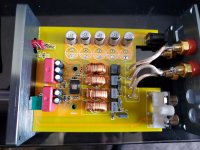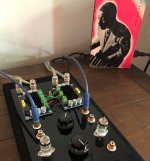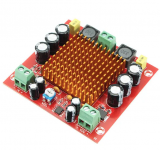Hello FauxFrench,
....................................
Thinking that the volume with my 12V supply and 4 Ohm speakers might diminish with the 20dB gain, I was a bit concerned about doing it, I'm completely wrong I'm pleased to say, very loud indeed is about still about 1/3 rotation of the pot.
.........................................................................
I had a thought about the pot and the switch, I have large 17" x 12" x 2" (425 x 300 x 50) wooden boxes that I put my amps in and need to have inputs and outputs on the panels. If I were to turn the switch on, set the pot at full volume, take leads from under the board to, two pots and one switch would that work?
Cheers - Jem
Hi Jem,
How much power you can get out of an amplifier mainly depends on the supply voltage and the load impedance, not the gain. The less gain, the more signal amplitude you need at the input to have the same power at the output. You compensate with an increase of signal level at the input.
With a 12V supply and a 4 Ohm load, you can get around 20W at the output. It will be sufficient for much. If you want more output power in 4 Ohm, you simply increase the supply voltage. 19.5 Volt (standard lap-top charger) will give you 45W in 4 Ohm. 24V is the maximum (70W!).
You can use the wooden box. Put the board with the volume potentiometer inside, turn the board ON and adjust the potentiometer to a suitable input sensitivity level. You can then add an external power switch and external potentiometer(s) at the input. Use 4K7 potentiometer(s).
Regards, FF
Last edited:
Without having checked the exact start-up circuit, I guess the ON/OFF switch integrated in the potentiometer just cuts/connects the supply power. I, myself, leave the potentiometer "ON" permanently and cut or connect the power to the power supply (power adapter). I hardly hear anything at power-ON or -OFF.
Of course: Turn the source ON before the amplifier board and turn the source OFF after the amplifier board. "Ca marche".
Of course: Turn the source ON before the amplifier board and turn the source OFF after the amplifier board. "Ca marche".
Hello FauxFrench,
Many thanks for the further information and advice I will order some 4K7 Pots today.
My CHP-70's will only take 18 Watts very suitable for low power.The first time I heard them was at Colin Topps house, he kindly invited me round to have a listen to his FH3's. The amplifier he used at the time was a 6 Watt valve jobbie, I must admit I was a bit concerned, but, concert level sound that filled his large room. The amplifier was not one of the 'soft' ones but proper Class A, bright, detailed and very fast. A bit like the TPA3116D2
Hello Erik,
I've just been into the garage to try the switch on the amp board, upon switching on ... nothing, upon switching off ... a tiny ptp that if I wasn't listening for it I wouldn't notice.
Cheers both - Jem
Many thanks for the further information and advice I will order some 4K7 Pots today.
My CHP-70's will only take 18 Watts very suitable for low power.The first time I heard them was at Colin Topps house, he kindly invited me round to have a listen to his FH3's. The amplifier he used at the time was a 6 Watt valve jobbie, I must admit I was a bit concerned, but, concert level sound that filled his large room. The amplifier was not one of the 'soft' ones but proper Class A, bright, detailed and very fast. A bit like the TPA3116D2
Hello Erik,
I've just been into the garage to try the switch on the amp board, upon switching on ... nothing, upon switching off ... a tiny ptp that if I wasn't listening for it I wouldn't notice.
Cheers both - Jem
Really happy with how this one sounds finally. Factory gain was set to 32db which also put some hiss in my speakers. Factory DC power caps were 10x Sanyo 470uf/35v
Currently using gain resistors:
R1: 10k
R2: open
Input cap: 2.2uf, unknown brand
Initially tried going up in size for DC caps (went to 4x 1500uf panasonic 63v) but the treble was bordering on shrill. Saw here that the datasheet recommended value is 220uf (TPA3116D2 Boards) and I had some leftover caps from my TPA3255 project so I put 5x 47uF 63v and it sounds just great now.
Powered by 19v / 3.5A laptop power supply
Currently using gain resistors:
R1: 10k
R2: open
Input cap: 2.2uf, unknown brand
Initially tried going up in size for DC caps (went to 4x 1500uf panasonic 63v) but the treble was bordering on shrill. Saw here that the datasheet recommended value is 220uf (TPA3116D2 Boards) and I had some leftover caps from my TPA3255 project so I put 5x 47uF 63v and it sounds just great now.
Powered by 19v / 3.5A laptop power supply
Attachments
I just built a halfinator with a TPA3116 mono board. Volume potentiometer on full but still not getting the most out of the speaker.
My power supply is 19.6v lifepo4.
With a laptop on full volume if I adjust input voltage I can go down to around 14.5v before I experience any clipping or distortion. On a smartphone the volume is much lower and even at 9v I don't experience any distortion.
Do people recommend a pre amp or replacing components in tpa3116, and if replacing, what components should I replace?
Thanks!
My power supply is 19.6v lifepo4.
With a laptop on full volume if I adjust input voltage I can go down to around 14.5v before I experience any clipping or distortion. On a smartphone the volume is much lower and even at 9v I don't experience any distortion.
Do people recommend a pre amp or replacing components in tpa3116, and if replacing, what components should I replace?
Thanks!
Hello eschamp,
Could be the way you've wired the speakers up, there's a PDF here with explanations: https://cie-wc.edu/Series_Parallel_9_14.pdf
Cheers
Could be the way you've wired the speakers up, there's a PDF here with explanations: https://cie-wc.edu/Series_Parallel_9_14.pdf
Cheers
Hello Eshamp,
In series the resistances add up 2 x 8 Ohm = 16 Ohms or 4 x 8 Ohm = 32 Ohm
Your voltage would have to double to drive 16 Ohm
See if you can find out how to get the total resistance down to 8 Ohm or even 4 Ohm by parallel wiring. This should solve the problem.
Cheers - Jim
In series the resistances add up 2 x 8 Ohm = 16 Ohms or 4 x 8 Ohm = 32 Ohm
Your voltage would have to double to drive 16 Ohm
See if you can find out how to get the total resistance down to 8 Ohm or even 4 Ohm by parallel wiring. This should solve the problem.
Cheers - Jim
Hello Eshamp,
Your speakers in parallel are down to 4 Ohms which should be fine. I see also that the speakers are 98 dB tweeter and 96 dB for the woofer. Goodness gracious then at 1 Watt it would be very dangerous to stand near them 95 dB being the pain and permanent damage threshold.
All you are ever going need is about 1/16th of a Watt.
Sadly I'm not expert enough to help you now, perhaps someone reading this will be able to help using what I have found out about the speakers.
I do hope so.
Cheers - J
Your speakers in parallel are down to 4 Ohms which should be fine. I see also that the speakers are 98 dB tweeter and 96 dB for the woofer. Goodness gracious then at 1 Watt it would be very dangerous to stand near them 95 dB being the pain and permanent damage threshold.
All you are ever going need is about 1/16th of a Watt.
Sadly I'm not expert enough to help you now, perhaps someone reading this will be able to help using what I have found out about the speakers.
I do hope so.
Cheers - J
Hello all,
After searching around the forums for a class D amp board I came across the posts here by FauxFrench who recommended a particular TPA3116D2 board, this one.
Heat sink removed to show the resistors under it, after seeing lots of others it does look like a proper job.
He explained that it used good components; was very close to the data sheet, did not have any filters or bluetooth and did not need a pre-amp. It's full 'google will find one' description is " KYYSLB DC12-24V TPA3116D2 Amplifier Board XH-M590 " FF went on to explain not to buy the one with two glued on heat sinks but the one with a single heat sink, this is removable with a screw in order to get to the SMD resistors under it.
Mine arrived and I powered it up, it hissed at 1/2 volume, I was advised to remove two 75k (753) resistors (watched a how to on YT) which reduced the gain from 36dB to 20dB, result not even a smidgeon of hiss. The lower gain didn't make any difference to volume levels that I noticed.
My speakers are Frugel Horn Mk3's that I made myself from the original drawings in 2011 with Mark Audio CHP-70's which are 4 Ohm, 86dB, 18 Watt. Looking at the TI data sheet I saw that at the 12V recommended for 4 Ohms I would get 20 Watts.
I was advised to change the 4 caps which are 470uF to 2,200uF which I did, that made it rather 'shouty' in the upper register, I changed those to 1,000uF, still a bit 'shouty' finally going back to the 470uF ones I splashed out a tenner for 4 Nichicon ones, 'shouty' gone.
In amongst that I was also advised to have to caps between the power supply and the amp, I introduced 25,000uF left over from an analog chip amp project. It sounded very nice, smooth and pleasant, but the bottom end sounded woolly and the top truncated, the bits in the middle a little less distinct.
I removed those and got the full force of the amp back, as Mr Hoyt said in another forum, what I got was "Gain".
I then conducted a test over many days by using two dummy loads, one in the class D and one in my 3886 chip amp. One fed the left and the other the right speaker and the inputs were connected to a DPDT switch so that I could go from one to another instantly from a listening position.
I've done this before and expected that at first there would be very little perceived difference, there wasn't. I'll not bore you with lists of music, the eventual outcome was the 3886 was slightly soft and the 3116 slightly faster and more detailed especially in the upper and lower registers.
I must emphasise that the differences are small and others may have chosen the smooth and pleasant rather than the fast and detailed.
I use this 12V 8.5 Amp power supply, cost 9GBP
I've just tried a 12v 2.5 Amp plug into the wall socket PS, no difference whatsoever. Looking at the TI data sheet one can see why "Feedback Power-Stage Architecture With high Power Supply Ripple Rejection reduces PSU requirements".
With the amp at waking the dead volume and a full range wall of electronic music.
I connected an ammeter in series with the +V output it registered between 0.2 to 0.4 Amps.
At 12v = 4.8 Watts divided by 2 = 2.4 Watts less 10% for efficiency wastage = 2.16 Watts or 1/2 that at 0.2 Amps.
Cheers - J
After searching around the forums for a class D amp board I came across the posts here by FauxFrench who recommended a particular TPA3116D2 board, this one.
An externally hosted image should be here but it was not working when we last tested it.
Heat sink removed to show the resistors under it, after seeing lots of others it does look like a proper job.
He explained that it used good components; was very close to the data sheet, did not have any filters or bluetooth and did not need a pre-amp. It's full 'google will find one' description is " KYYSLB DC12-24V TPA3116D2 Amplifier Board XH-M590 " FF went on to explain not to buy the one with two glued on heat sinks but the one with a single heat sink, this is removable with a screw in order to get to the SMD resistors under it.
Mine arrived and I powered it up, it hissed at 1/2 volume, I was advised to remove two 75k (753) resistors (watched a how to on YT) which reduced the gain from 36dB to 20dB, result not even a smidgeon of hiss. The lower gain didn't make any difference to volume levels that I noticed.
My speakers are Frugel Horn Mk3's that I made myself from the original drawings in 2011 with Mark Audio CHP-70's which are 4 Ohm, 86dB, 18 Watt. Looking at the TI data sheet I saw that at the 12V recommended for 4 Ohms I would get 20 Watts.
I was advised to change the 4 caps which are 470uF to 2,200uF which I did, that made it rather 'shouty' in the upper register, I changed those to 1,000uF, still a bit 'shouty' finally going back to the 470uF ones I splashed out a tenner for 4 Nichicon ones, 'shouty' gone.
In amongst that I was also advised to have to caps between the power supply and the amp, I introduced 25,000uF left over from an analog chip amp project. It sounded very nice, smooth and pleasant, but the bottom end sounded woolly and the top truncated, the bits in the middle a little less distinct.
I removed those and got the full force of the amp back, as Mr Hoyt said in another forum, what I got was "Gain".
I then conducted a test over many days by using two dummy loads, one in the class D and one in my 3886 chip amp. One fed the left and the other the right speaker and the inputs were connected to a DPDT switch so that I could go from one to another instantly from a listening position.
I've done this before and expected that at first there would be very little perceived difference, there wasn't. I'll not bore you with lists of music, the eventual outcome was the 3886 was slightly soft and the 3116 slightly faster and more detailed especially in the upper and lower registers.
I must emphasise that the differences are small and others may have chosen the smooth and pleasant rather than the fast and detailed.
I use this 12V 8.5 Amp power supply, cost 9GBP
An externally hosted image should be here but it was not working when we last tested it.
I've just tried a 12v 2.5 Amp plug into the wall socket PS, no difference whatsoever. Looking at the TI data sheet one can see why "Feedback Power-Stage Architecture With high Power Supply Ripple Rejection reduces PSU requirements".
With the amp at waking the dead volume and a full range wall of electronic music.
I connected an ammeter in series with the +V output it registered between 0.2 to 0.4 Amps.
At 12v = 4.8 Watts divided by 2 = 2.4 Watts less 10% for efficiency wastage = 2.16 Watts or 1/2 that at 0.2 Amps.
Cheers - J
Sorry for my delayed comments - had to travel for a period helping with a Covid-19 tidy-up in the family. For those who may still doubt if Covid-19 is for real, my experience is that it indeed is and it kills or causes longer term physical damage in rather unpredictable ways. No hoax - watch out.
Electronics: Very nice report by Jem. My situation is heavy 3-way floor speakers (Jamo707, 8 Ohm, with extra damping in the bass chamber) used mainly for symphonic rock (ELP etc.). As Jem writes, the power line decoupling may influence the sound depending on the speakers. The power supply may even have a say. My impression is that horn speakers are typically high efficiency with a sensitive mid-range.
Let us know about personal experiences. At least most agree that the board is good "value for money". I typically use a 19V laptop "brick" with my board.
Electronics: Very nice report by Jem. My situation is heavy 3-way floor speakers (Jamo707, 8 Ohm, with extra damping in the bass chamber) used mainly for symphonic rock (ELP etc.). As Jem writes, the power line decoupling may influence the sound depending on the speakers. The power supply may even have a say. My impression is that horn speakers are typically high efficiency with a sensitive mid-range.
Let us know about personal experiences. At least most agree that the board is good "value for money". I typically use a 19V laptop "brick" with my board.
Last edited:
Hello FF,
Thanks for the message I'm pleased that you are OK. Very sad times you have my sympathy. We are both still in personal 'lockdown' and intend to remain so until a vaccine emerges.
It isn't until it happens to someone close to you that you realise just how dangerous the virus actually is.
Best wishes - Jem
Thanks for the message I'm pleased that you are OK. Very sad times you have my sympathy. We are both still in personal 'lockdown' and intend to remain so until a vaccine emerges.
It isn't until it happens to someone close to you that you realise just how dangerous the virus actually is.
Best wishes - Jem
- Home
- Amplifiers
- Class D
- TPA3116D2 Amp




